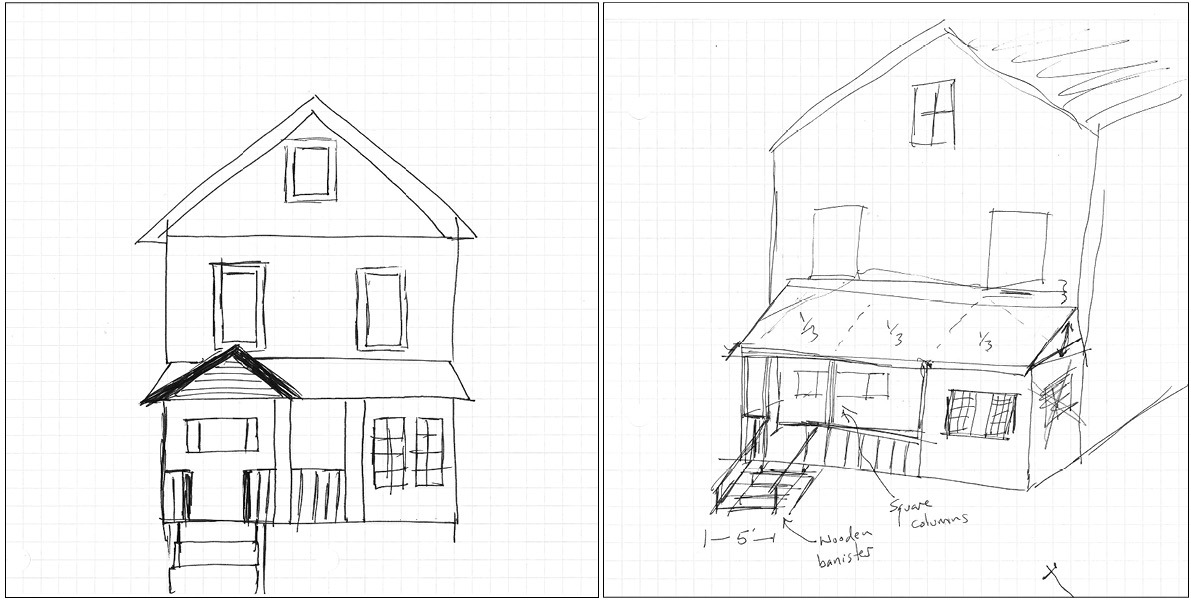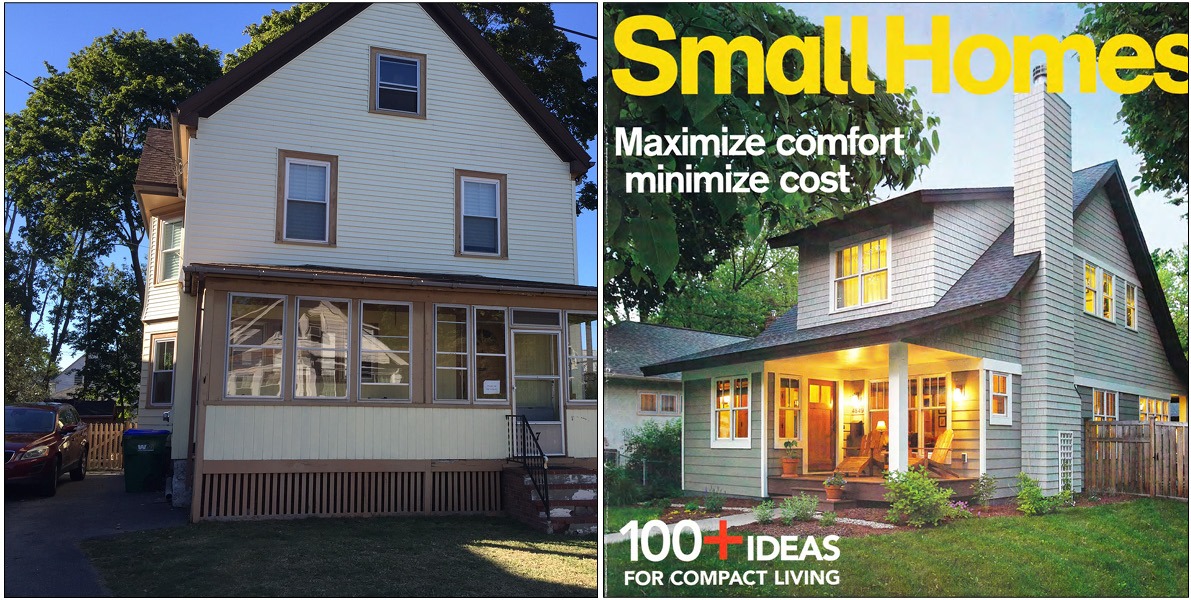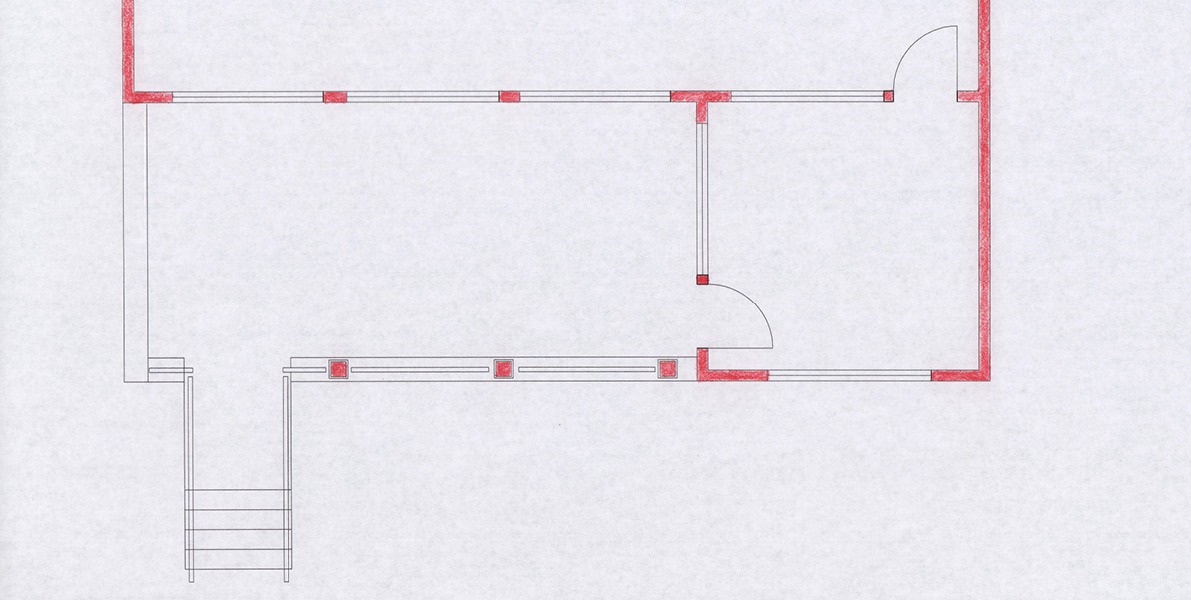
Start Every Project with a Floor Plan
The importance of starting with a floor plan cannot be emphasized enough. A new client writes: “Hello Alla. We have been renovating a house we bought last year, and our next project will be the front porch. The basic concept is to turn the current sunroom into 2/3 open porch and 1/3 mudroom/entry way. We would also like to move the stairs to the left, closer to the driveway.”
He continues: “What we’d like your expertise on are design details, such as type/ size of windows, lighting, door, spacing, column design, railing design, and walkway up to the porch with perhaps a yard feature that can show the house number.”
Attached are some sketches of what they are thinking, photos of existing, plus an inspiration from a magazine of the overall look/feel they’d like to “hit.”(see below)

Conceptual sketches: new porch/mudroom in elevation

Existing conditions vs. desired outcome (inspiration)
Nice project. The object is to create a new entry sequence and to relate it to the rest of the layout. But I need dimensions. I can’t help until I see a floor plan. That is the starting point. All of the decisions, such as “type/size of windows, lighting, door, spacing, column design, railing design” are dependent on the floor plan.
Start every project with the floor plan is the #1 design tip
When remodeling, clearly, you need to measure and record existing conditions first. That’s done with a floor plan. When designing from scratch, after establishing a parti, it’s still the case.
FLOOR PLAN is a conventional and systematic representation of your design in a way that others can understand. It should be drawn in proportion to actual size. I recommend using 1⁄4” = 1’0” as your scale.
Here’s a crush course on the process of drawing a floor plan as outlined in my e-how-toBOOK DIY Like an Architect: 11-step method.
FLOOR PLAN is a view from above drawn as if an imaginary horizontal plane cuts through a section being drawn so as to remove a part above the cutting plane. A plan is represented best if the horizontal cut is taken through all openings (such as doors and windows) as well as all structural elements (such as columns). When solid mass is cut through, it is shown with heavier line weight or is shaded in. Thinner lines indicate objects below the cutting plane (such as window sills). Dashed lines indicate objects above (such as skylights).
- Add wall thickness for both exterior and interior walls.
- Draw wall openings, including windows and doors.
- Locate stairs. Keep in mind that you need 11” in plan to go up 7”. Relate first and second levels to each other by overlaying drawings. Treat a staircase as an architectural feature. Place it in the key position.
- Locate and draw bathroom and kitchen fixtures. Show scale and function by including built-in elements, such as counters, sinks, etc.
- Create passages that are welcoming. Breathe life into circulation that ties spaces together. Avoid long hallways by connecting individual rooms with common spaces. Create points to walk toward.
- Mentally walk through the spaces you are designing. Be mindful of barriers you might be creating.
- Establish hierarchy and devise ways of directing attention by leading from general to specific while providing order-giving clues.
- Be very deliberate about door locations — they are extremely important! The way you move from room to room requires careful consideration.
- Keep geometry pure and align elements thoughtfully — you are thinking in terms of best use and efficiency. Now is the time to justify every line you draw — “I like it” is not good enough of a reason. Be deliberate!

Take a look at the hypothetical floor plan of the 2/3porch & 1/3 mudroom (above). I drew it quickly to illustrate the point. Once the skeleton is outlined, it’s easy to see relationships and to envision what “design details, such as type/size of windows, lighting, door, spacing, column design, railing design” might be. Wouldn’t you agree? If you have any questions, do not hesitate to ask them here. Please post your comments & share stories below.
SHARE
Post a Comment
You must be logged in to post a comment.




Mia Kazovsky
This is fascinating! Everyone wants to be a DIYer and expore their individual styles, but it is important to remember that in some cases a professional architect knows things that the DIYer might not have even thought twice about. For example, who knew that you need to remember to include WALL THICKNESS in a floor plan, let alone to always start with a floor plan. I didn’t know, but luckily you, DIY Ally, did!
Alla DIY Ally
You are SO RIGHT, Mia! Thank you for your vote of confidence!